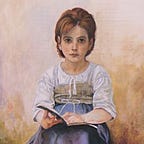Why writing percentages as decimals and vice-versa is problematic
Since I started working in the UK in maths education, I have been surprised to see maths questions of the type “Write 0.35 as a percentage.” (And quite annnoyed to read on numerous websites “To express a decimal as a percentage, simply multiply the decimal by 100.”) I haven’t seen so far any similar questions in French (which explains my surprise), except on websites translated from English. I want to explain here why I don’t like them.
First, I can try and make an analogy with English grammar. Some words can be used either as adjective or as adverb. Take ‘parallel’ for instance: “The two lines are parallel” (adjective), and “The path runs parallel to the train tracks” (adverb). However, it doesn’t mean that any adjective can be used as an adverb. You don’t say “Please speak quiet” but “Please speak quietly.” Some people may actually get confused and do use for instance ‘perpendicular’ as an adverb — just search “move perpendicular to” on any search engine to be convinced.
These maths questions about writing percentages as decimals and vice versa are symptomatic of a similar confusion. In the maths world, we have fractions that can describe either a number or a proportion (that is, a part-to-whole ratio), but it doesn’t mean that a proportion and a number are the same thing. A percentage is actually a fraction that describes a part-to-whole ratio and whose denominator is 100. A decimal is a number. So, I find that writing 0.35 = 35% is like saying “please speak quiet” — we might understand what is meant, but it’s grammatically incorrect.
Interestingly, part-to-part ratios receive a great deal of attention in the English maths curriculum compared to the French one for instance. But, so far, I’ve never seen anyone asking students to write a ratio, e.g. 3 : 4, as a decimal (0.75) and vice-versa. Yet, when we say e.g. that the width and length of a rectangle are in a 3 : 4 ratio, it mathematically means that w / l = 3 / 4, that is, w = 0.75 × l. It is mathematically equivalent to the fact that if 3 out of 10 children, or 30% of children, live in poverty in the UK, then the number of children who live in poverty is 0.3 times the total number of children. We see here the link between 3 : 4 and 0.75, and between 30% and 0.3.
So, why are pupils asked to write 0.3 = 30% but not to express 0.3 as 3 : 10?
It certainly comes from the fact that a fraction expressing a number is very closely related to a fraction expressing a part-to-whole ratio indeed. For instance, the number 2/5 (which is given by 2 ÷ 5) is also 2/5 (two fifths) of 1 (so, here, 2/5 is a part-to-whole ratio). From there, it’s easy to confuse the decimal form of the number 2/5 with the proportion 2/5, and, by extension, to not distinguish between numbers (decimals in particular) and percentages. But it’s conceptually wrong.
Even if I would agree that percentages, as soon as they are used as operators, will behave exactly as their “decimal form”, my concern is that making this conceptual confusion early on doesn’t help children to grasp the concept of ratio and rate.
To avoid that, I believe it is important that, when teaching decimals, we explain that “a tenth” implicitly means “a tenth of a one” or “1/10 of 1” or “1 ÷ 10”- just as “a ten” is “10 times a one” or “10 × 1”, “a hundred” is 100 times a one, etc. Using base 10 materials can prove very useful here.
Furthermore, we can show that e.g. the number 2/5, that is, 2 ÷ 5, which can be seen as 1/5 of 2 (we split 2 in 5 groups), is the same number as 2/5 of 1, for instance with diagrams like these.
Actually a nice illustration of the identity property and commutativity of multiplication!
Finally, I’ve noted that the confusion between numbers and proportions penetrates the English language of maths questions as well. For instance, I’ve read word problems about 0.2 of a jam jar. It’s not correct English. Either you say 0.2 jam jar, then ‘jam jar’ is considered a unit and 0.2 is the number of units, or you say 2/10 of a jam jar, then the 2/10 is a part-to-whole ratio and the full jam jar is the whole. In the other way round, consider this example (not seen yet!): “I spent 200% hours reading a book.“ How does it sound?
